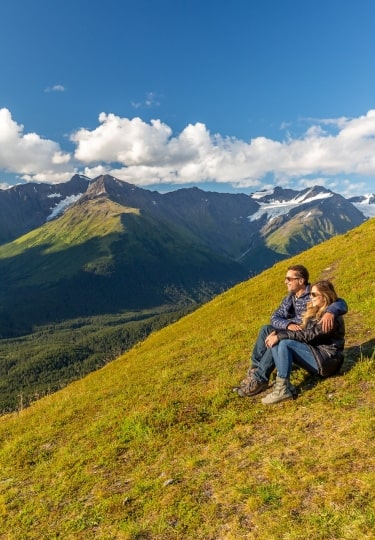Hiking in Alaska promises rugged wilderness, unspoiled natural beauty, and amazing wildlife sightings. With hundreds of hiking trails and spectacular national parks to explore, there are endless options for those who choose to wander into Alaska’s wild terrain.
Whether you’re a beginner who simply wants to walk through gentle nature paths or an advanced hiker ready to climb a glacier, there are plenty of different trail options throughout the state that are suited for all ability levels.
From treks that retrace the steps of the Gold Rush to scenic strolls in Tongass National Forest, here are some of the best hikes in Alaska for you to experience on your next trip to the Last Frontier.
Mendenhall Glacier, Juneau
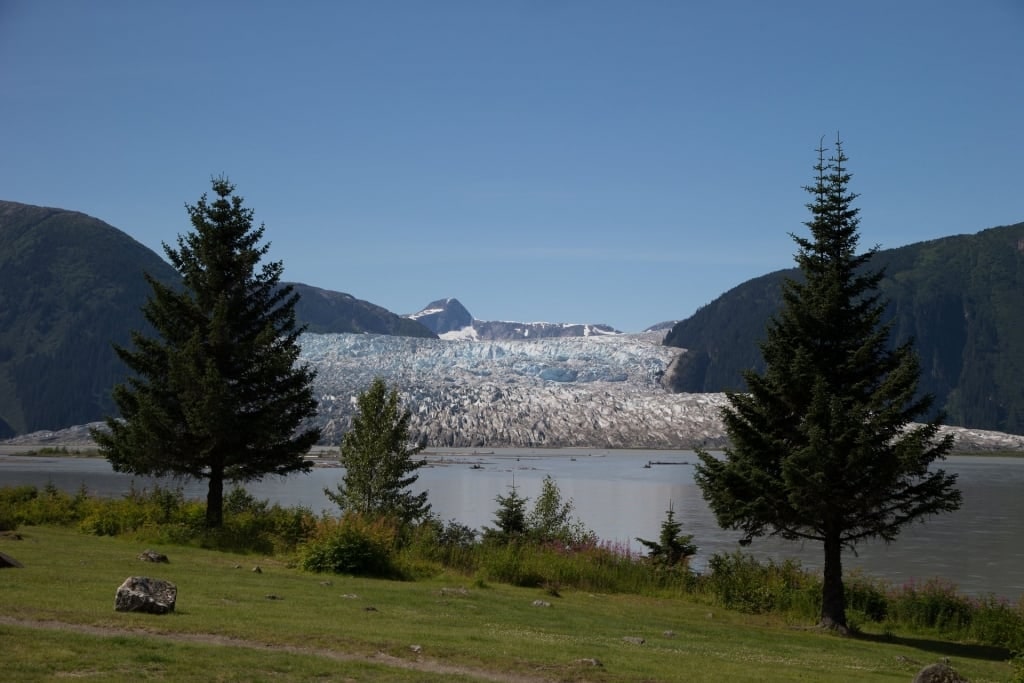
Mendenhall Glacier, Juneau
In Juneau, the capital of Alaska, go on a thrilling hike to one of Alaska’s most accessible glaciers, Mendenhall Glacier.
Located at the Mendenhall Glacier Visitor Center, this 13-mile-long glacier is part of the Juneau Ice Field and one of the city’s most popular natural attractions. While a visit to the park provides spectacular views of the glacier from afar, one of the best ways to experience this icy natural wonder is by going on a hiking trail that gets you up close and personal.
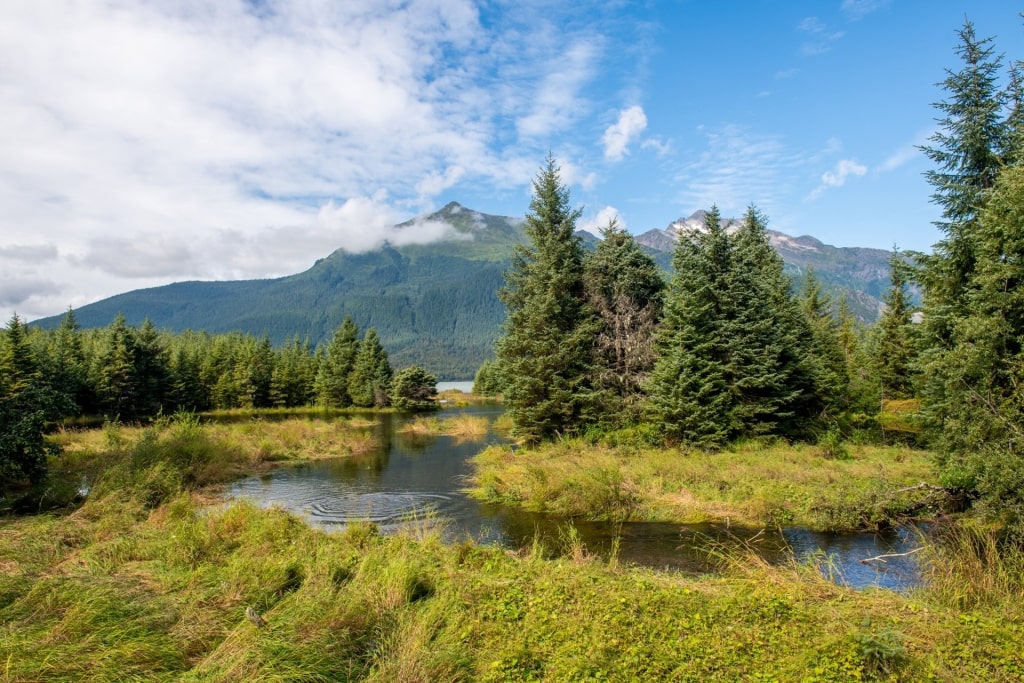
Mendenhall Lake, Juneau
There are multiple trails to choose from to reach Mendenhall Glacier when hiking in Alaska, and most routes usually take anywhere between two to three hours to reach the face of the glacier. Along the way, you’ll enjoy lovely views of Mendenhall Lake, where you’ll see large icebergs floating in the water. On some trails, you’ll be able to admire a 377-foot waterfall, too. Be on the lookout for salmon swimming upstream or even black bears trying to feast on them.
Chilkoot Trail, Skagway
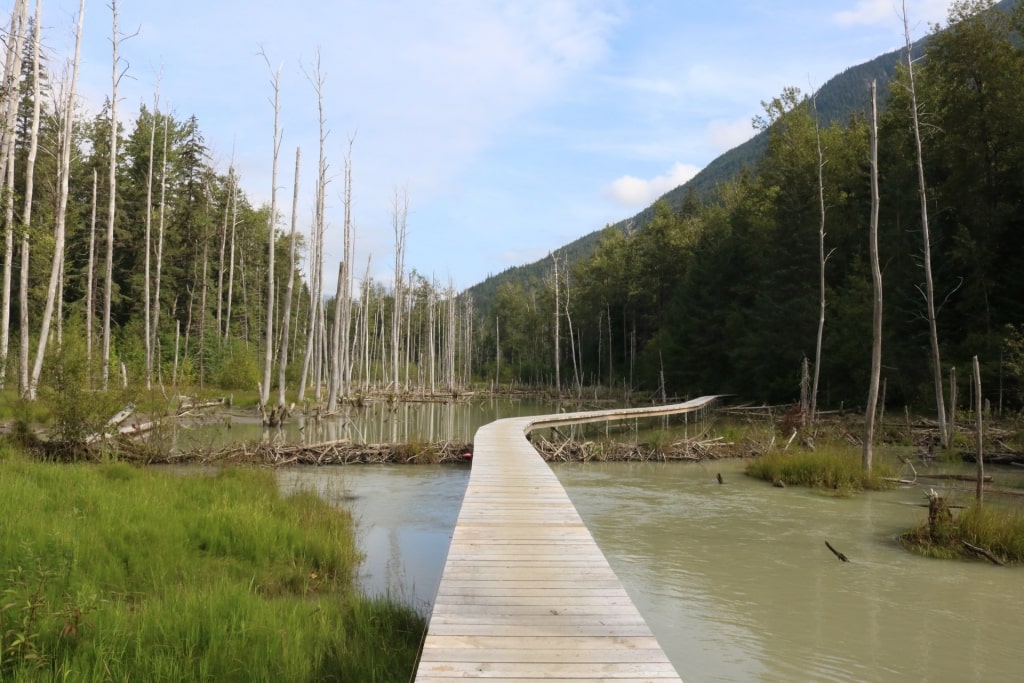
Chilkoot Trail, Skagway
Follow in the footsteps of Gold Rush seekers as you make your way through the Chilkoot Trail, a 33-mile route through the mountains that was once used by those hoping to strike gold in the Yukon River. Today, it’s a designated U.S. National Historic Landmark.
Though the full trail takes a few days, if you’re a beginner hiker or are short on time, then you can hike a small portion of it. The picturesque stroll includes unforgettable views of alpine lakes, Gold Rush artifacts, colorful wildflower fields, and lush fjords in the distance. It’s one of the best hikes in Alaska for both history buffs and nature enthusiasts.
Kenai Fjords National Park, Seward
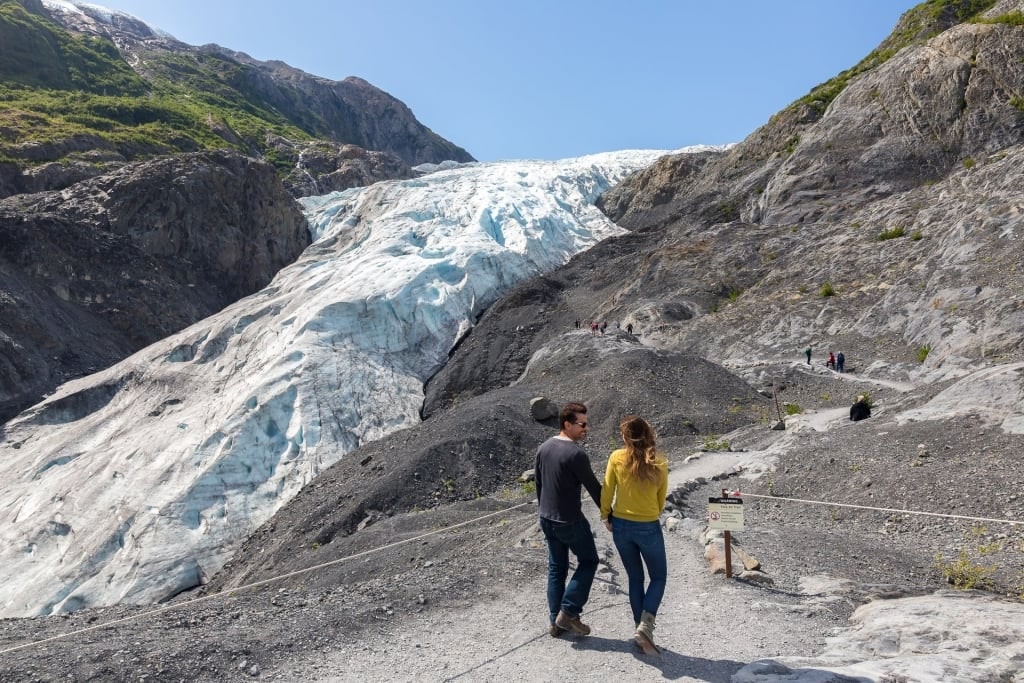
Exit Glacier, Seward
In Seward, head to the stunning Kenai Fjords National Park, where mountains, icebergs, and the towering Exit Glacier await. Almost half of this park is covered in ice, mainly by the Harding Icefield, which spawns off over 40 glaciers.
Experience what it’s like to see one of Alaska’s best glaciers up close by going on one of the trails leading up to Exit Glacier, most of them suited for all levels of hikers. Walk past markers that point out how much the glacier has receded throughout the years, and learn all about the vegetation that has taken over the barren landscape.
One of the most popular trails is the Edge of the Glacier trail, which is not only wheel-chair accessible but also leads you to one of the best spots to take a photo with the glistening ice of Exit Glacier in the background.
Chichagof Island, Icy Strait Point
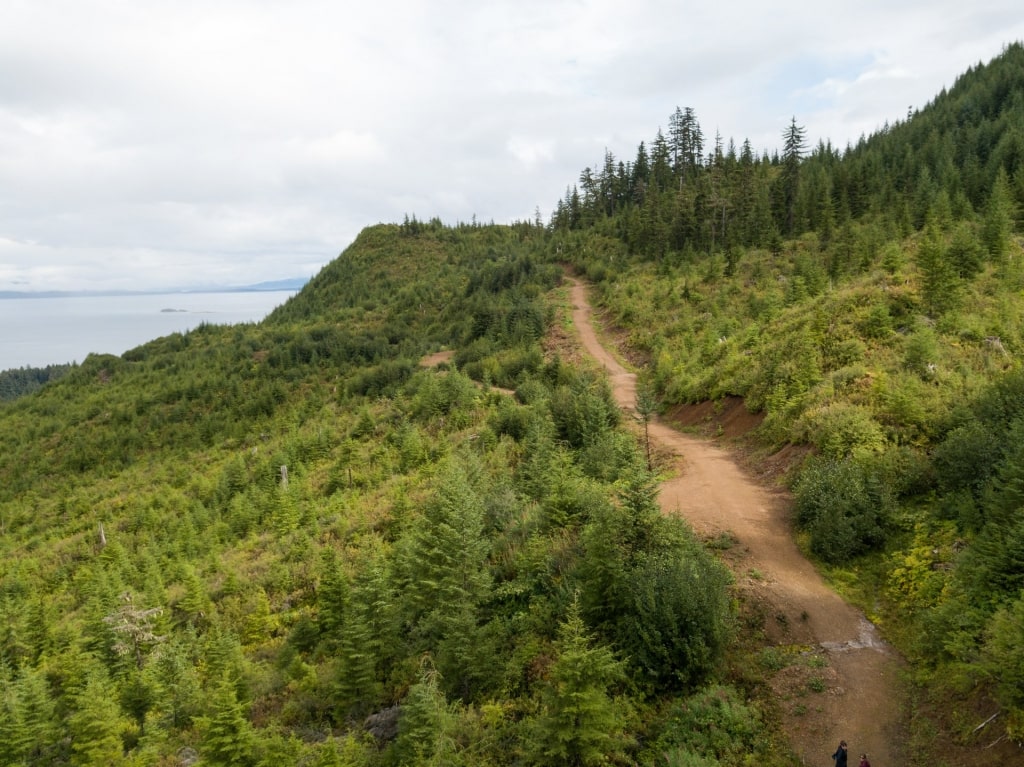
Chichagof Island, Icy Strait Point
In the port of Icy Strait Point, explore the wilderness of Chichagof Island, the fifth-largest island in the United States and one of the best places to go hiking in Alaska.
Located within the Tongass National Forest, Chichagof Island has the highest population of brown bears per square mile and is home to several Tlingit communities, including Hoonah, the largest Tlingit village in the world.
Go on a nature hike around Chichagof Island’s rugged surroundings, and enjoy lovely panoramic views of the Spasski River Valley, lush fjords, and local wildlife, like the island’s brown bears and perhaps even a humpback whale in the distance.
Mount Roberts, Juneau
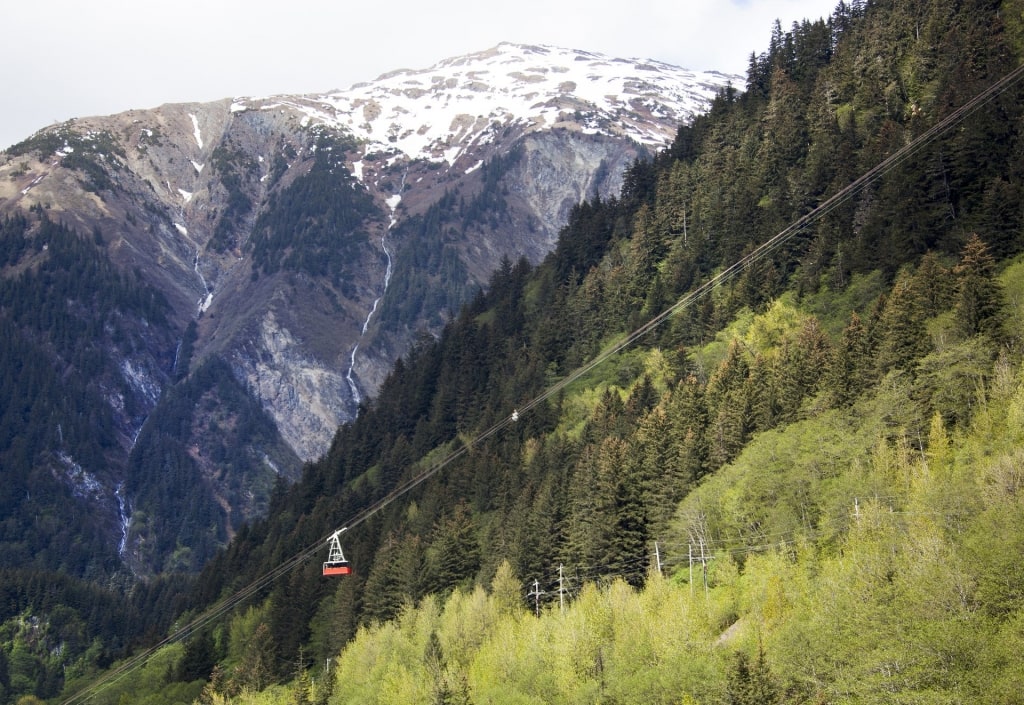
Mount Roberts, Juneau
One of the best things to do in Juneau is to go on a hike up Mount Roberts Trail, where you’ll trek among wildflowers and wildlife. Hike from the bottom of the mountain all the way up to its summit, or take a scenic tram up to the Mount Roberts Mountain House, where you’ll be standing 1,800 feet above sea level and enjoy some of the best views of Juneau in the distance.
Once you’re done taking photos of the view, start the hike up to Mount Roberts, where you’ll be surrounded by mountain peaks and alpine meadows and may encounter bald eagles, deer, mountain goats, and even black bears along the way.
Talkeetna Lakes Park, Talkeetna
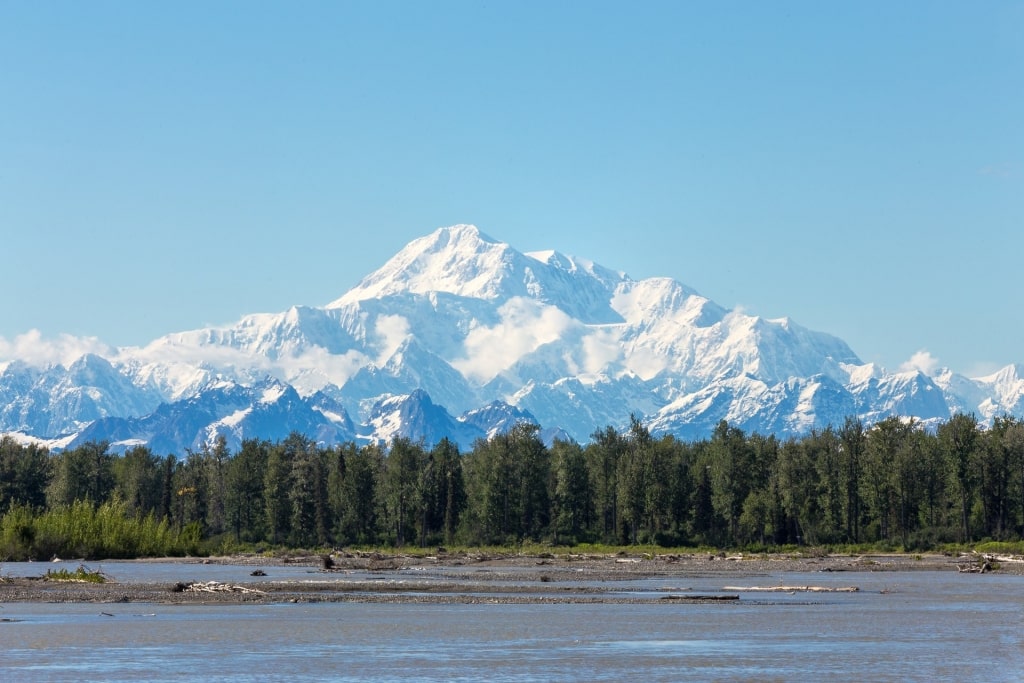
Talkeetna Lakes Park
Evergreen woods, Alaskan wildlife, and gorgeous nature views are all a part of the experience when hiking around Talkeetna Lakes Park, just outside of the town of Talkeetna.
Along the park’s scenic three-and-a-half mile walking trail, you’ll trek through the area’s dense woods and sparkling Alaskan lakes, where you can hop on a canoe or go fishing. Don’t forget to bring a pair of binoculars too, as the park is home to over 100 different bird species.
Denali National Park, Denali
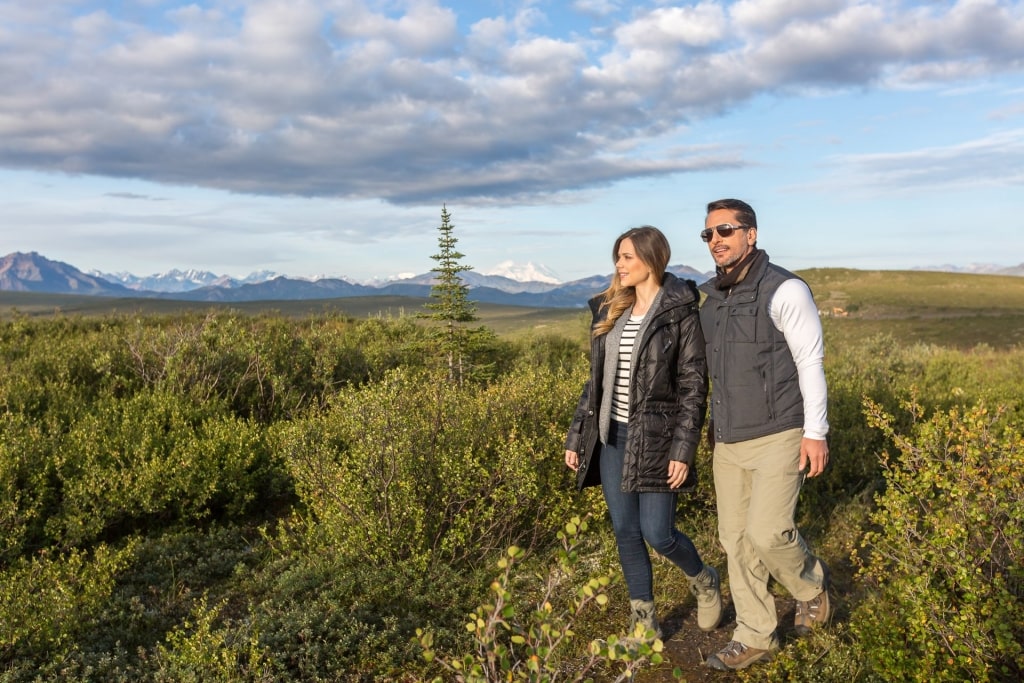
Denali National Park
One of the best national parks in Alaska, Denali National Park is a sprawling paradise filled with glacial rivers, frozen tundra, snow-capped mountains, and the highest peak in North America, Denali.
There are a few marked trails around the park, such as the popular Horseshoe Lake Trail, where you’ll see one of the best views of the Nenana River; the Triple Lakes Trail, Denali’s longest trail, where you’ll pass by three spectacular lakes; and the Savage River Loop Trail, which is suitable for kids and takes you through the park’s tundra, where you’ll most likely see Dall sheep and caribou.
Sitka National Historical Park, Sitka
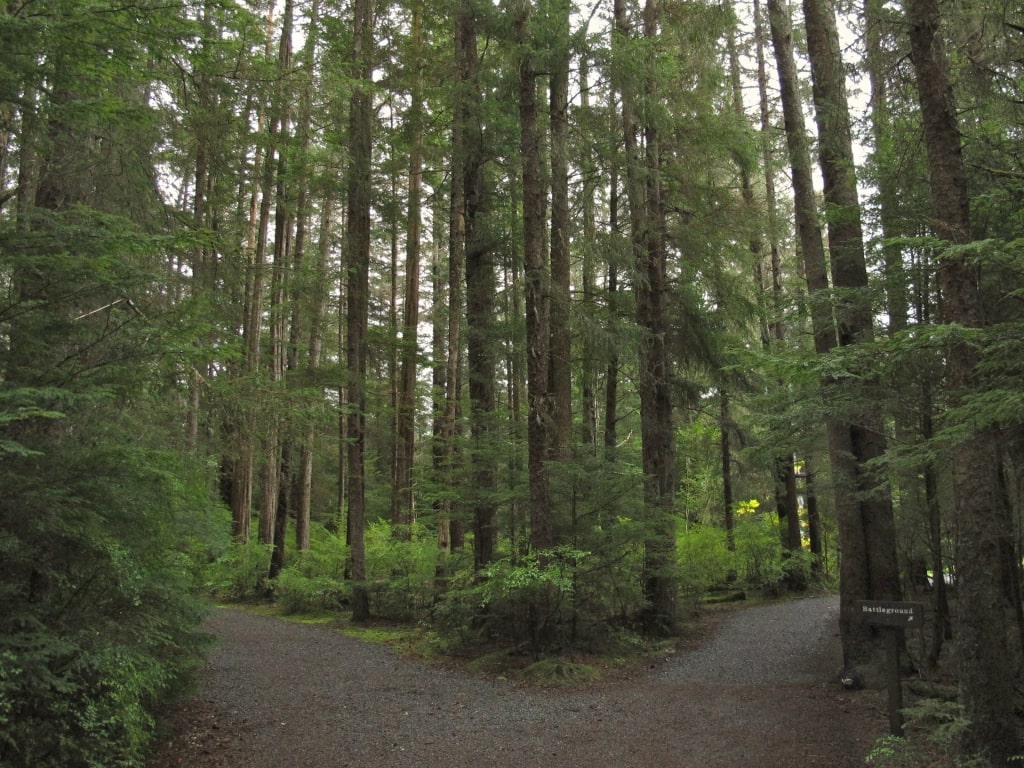
Sitka National Historical Park
Established in 1890, Sitka National Historical Park is Alaska’s oldest park—and also its smallest. The park was created as a tribute to the Battle of Sitka between the Russians and the local Tlingit tribe, which took place at the site in 1804.
The park is a wonderful family-friendly destination offering kid-centered activities and easy yet scenic trails. Amble along the Russian Memorial Loop Trail, a gentle path that boasts impressive views of the area’s coastline and snow-capped mountains on the horizon.
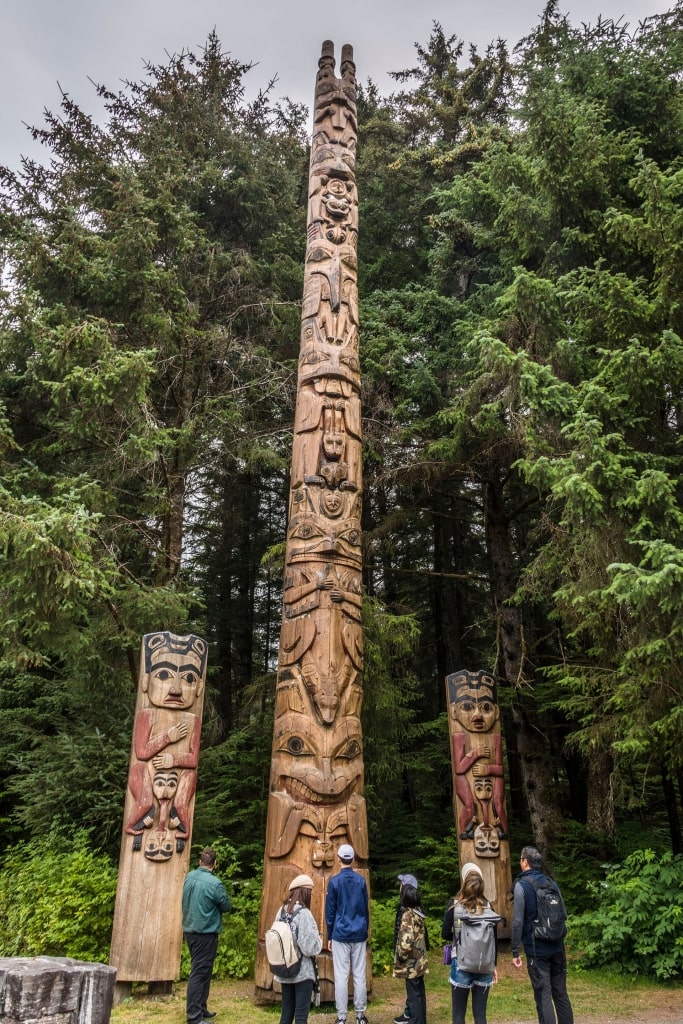
Totem Trail, Sitka National Historical Park
The highlight of the park is the Totem Trail, also known as Lover’s Lane, where you’ll find 18 original and replica Native American totem poles. Go on a guided walk of the 1.6-mile-long trail, and learn all about the Battle of Sitka, the culture of Alaska Natives, and what each different totem pole represents.
During your hike, you’ll also cross the Indian River, where you’ll watch salmon make their way upstream to spawn.
Laughton Glacier, Skagway
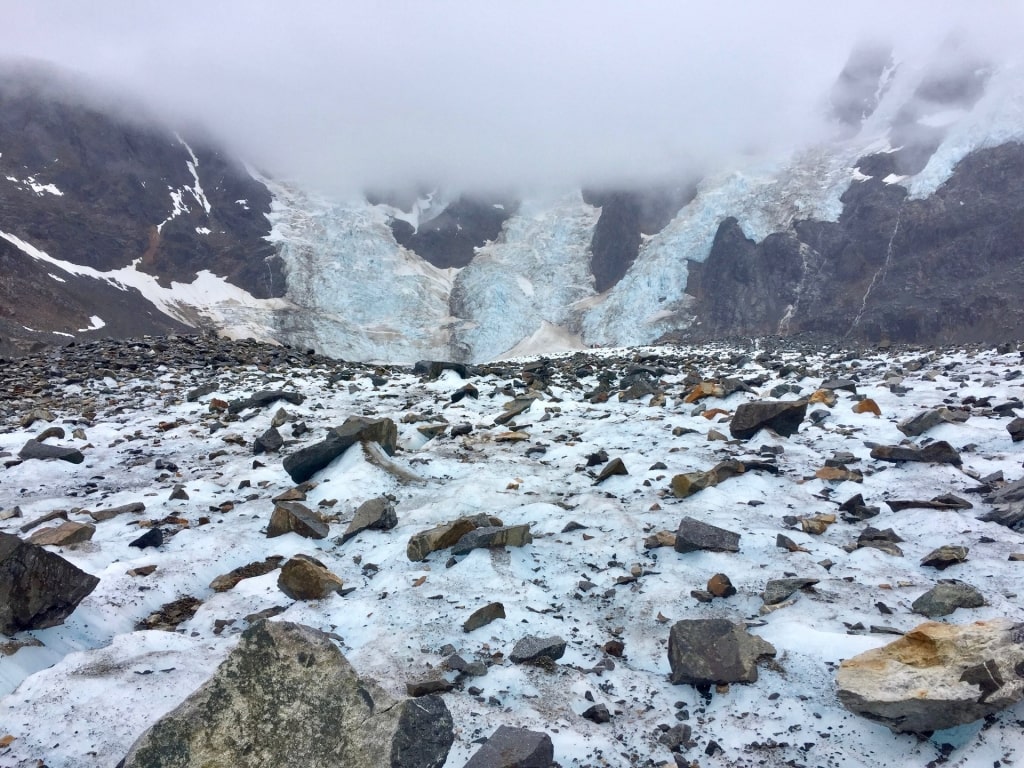
Laughton Glacier, Skagway
Hop aboard the White Pass Railroad, a scenic vintage train ride that takes you past cascading Alaskan waterfalls, glacial rivers, and snowy mountain peaks.
Once the train ride ends, you’ll disembark and begin your hike towards Laughton Glacier. Along the moderate trail, you’ll discover gorgeous flora and fauna, and spot some of the most popular animals in Alaska including moose, bears, and mountain goats.
As you get closer to Laughton Glacier, you’ll have to navigate trickier terrain including a rocky boulder field. Once you reach the icy structure, marvel at its frozen blue facade, take photos of its exposed crevasses, or put on a pair of ice spike boots and climb on top of the glacier.
Mount Alyeska, Girdwood
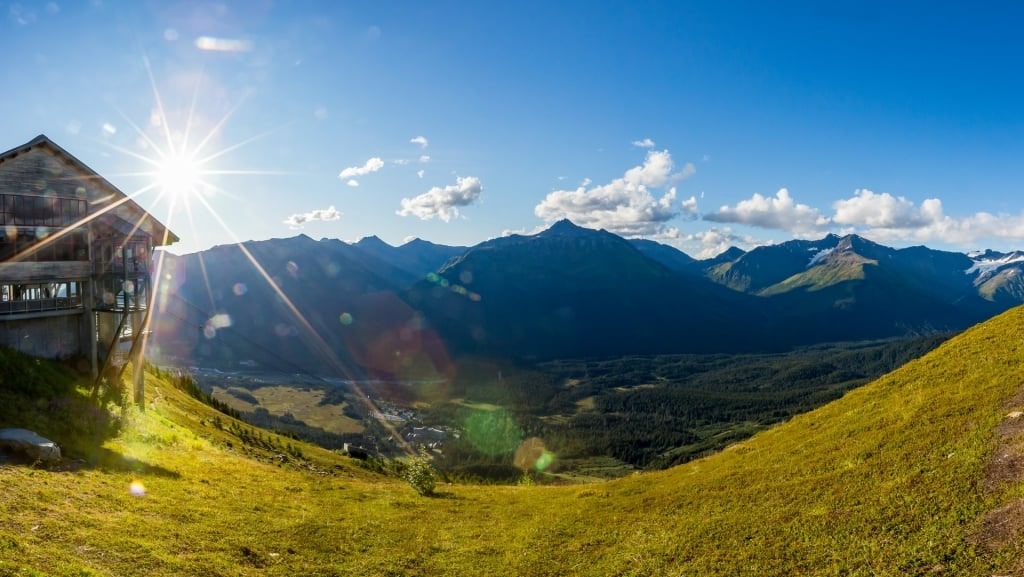
Mount Alyeska, Girdwood
The Girdwood Valley is a nature lover’s dream. Surrounded by the lush Chugach Mountains, this glacial carved valley features hiking trails up Mount Alyeska, ranging from easy to advanced.
While you can take an aerial tram up to Mount Alyeska’s summit, there are marked trails that journey up the mountain and through the temperate rainforest. Some of them traverse over pathways that are used as ski trails in the winter.
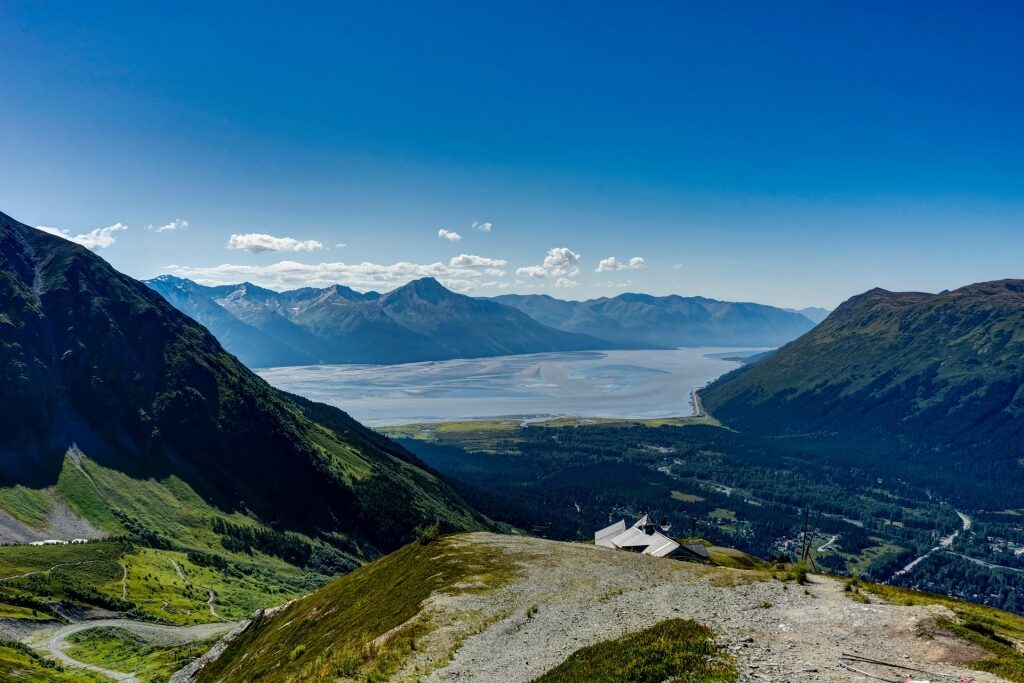
Mount Alyeska, Girdwood
Throughout your hike, you’ll see wildflower fields and moss-covered boulders. At the top, marvel at the famous seven hanging glaciers and the peaceful stillness of the waters of Turnagain Arm.
Tongass National Forest
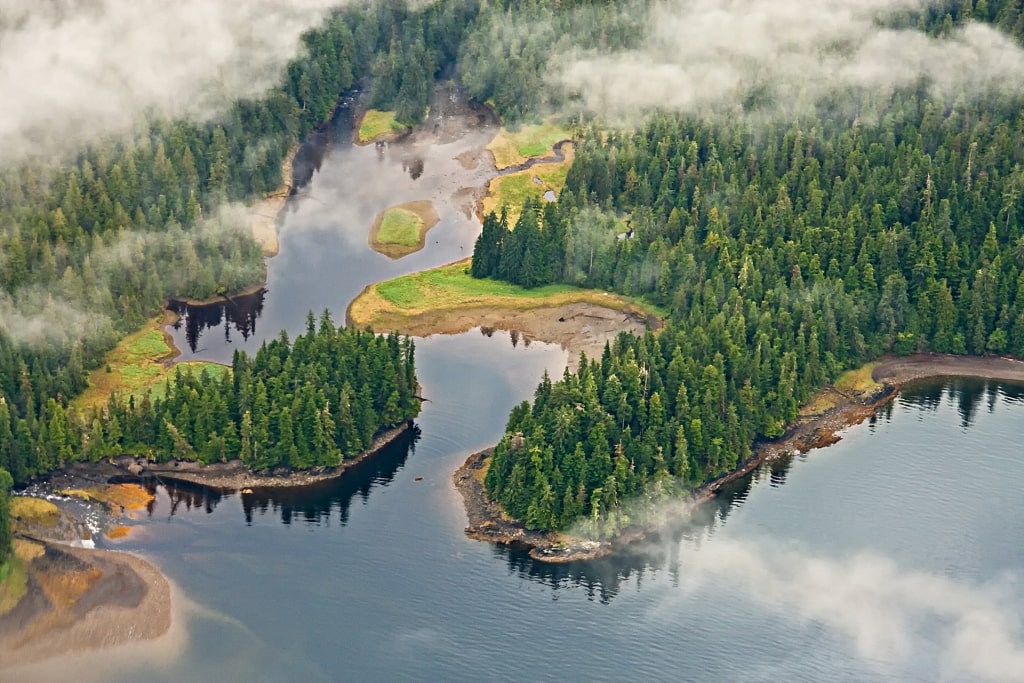
Tongass National Forest
Tongass National Forest is one of Alaska’s crown jewels. Spanning over 500 square miles (or roughly the size of West Virginia), Tongass National Forest is the largest temperate forest in the world and can be accessed throughout major Alaskan cities like Sitka, Skagway, and Ketchikan.
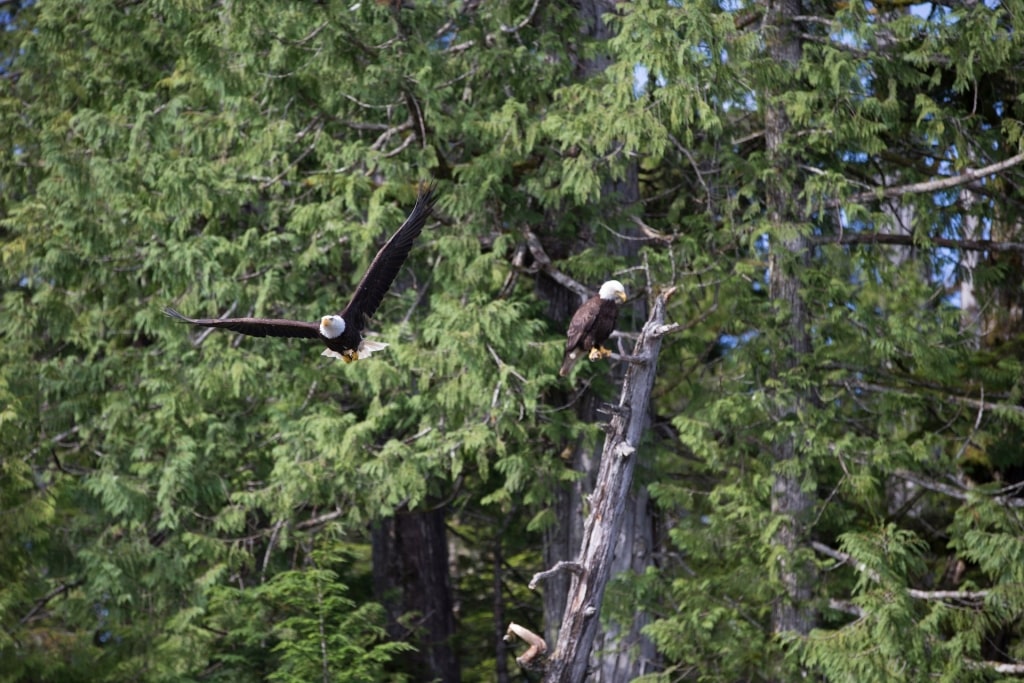
Tongass National Forest
From downtown Ketchikan, head up the clearly marked gravel paths and make your way past alpine lakes, climbing waterfalls, and verdant rainforest. Take in the gorgeous landscape full of snow-covered mountains and panoramic views of Ketchikan below. Be on the lookout for wildlife including soaring bald eagles, wolves, black bears, and mountain goats.
Make your way through the forest’s tree canopies, where you’ll be surrounded by red cedar trees, hemlock, alders, and spruce, along with berry bushes such as salmonberries, blueberries, and huckleberries.
In Sitka, go on a hike around Thimbleberry Trail, a route that promises spectacular views of the rainforest’s mountains, trees, and lakes. Or take a walk along Mosquito Cove Trail, where you’ll pass through a hemlock-spruce forest, stroll next to the coast, and spot Alaskan birds at the Starrigavan Estuary.
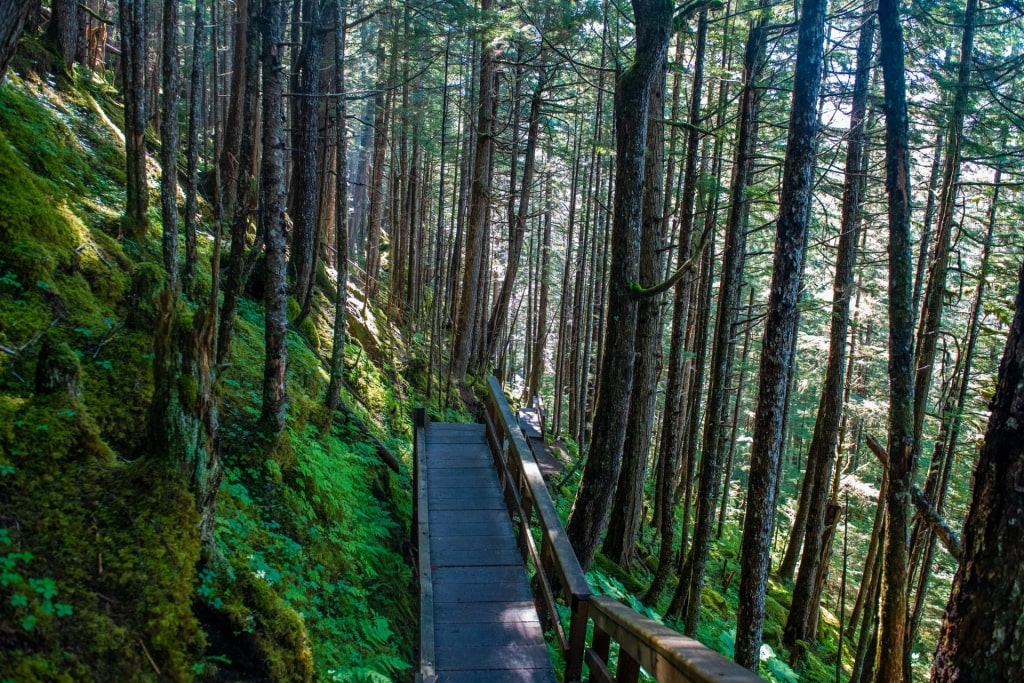
Tongass National Forest
Regardless of where you decide to enter while hiking in Alaska, venturing into Tongass National Forest promises an unforgettable journey into the state’s unbounded beauty.
Denver Glacier Trail, Skagway
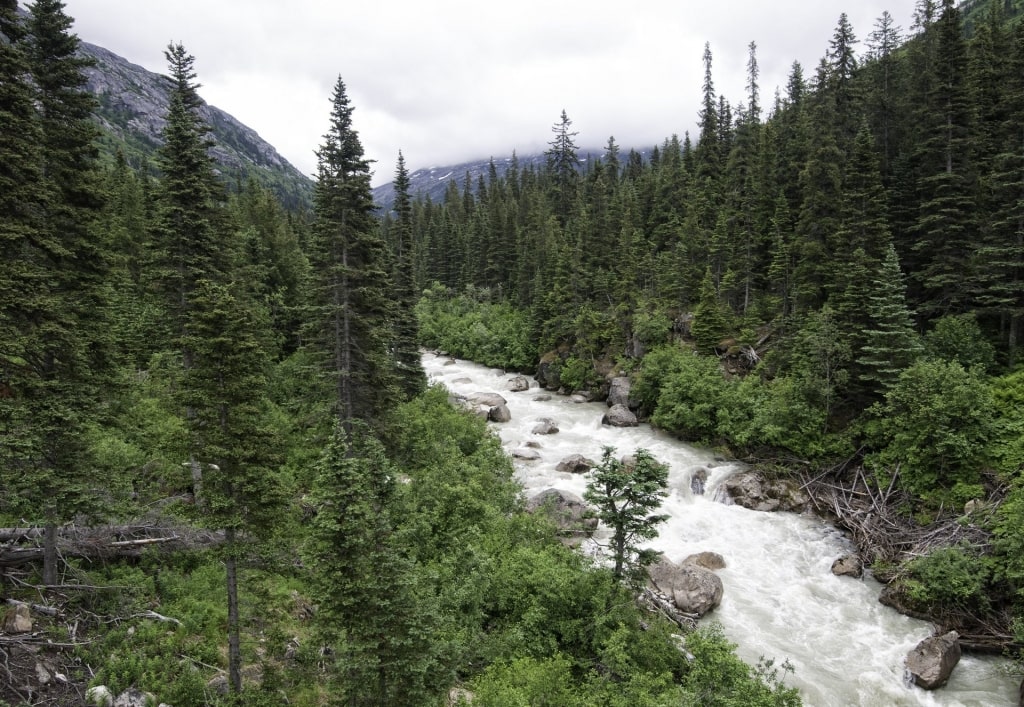
Skagway River
Sightseeing opportunities abound during a hike on the Denver Glacier Trail in Skagway. After taking a six-mile train ride on the White Pass & Yukon Route Railway, you’ll stop near a caboose cabin that marks the beginning of the Denver Glacier Trail, an easy route that runs parallel to the East Fork of the Skagway River.
Enjoy this mostly flat walk inside a coastal forest, where you can enjoy one of the most memorable things to do in Skagway—spotting bears, moose, and other Alaskan wildlife. Stop and enjoy the natural beauty of the Tongass National Forest, where you’ll see stunning vistas of the Sawtooth Mountains and lovely views of the river nearby. At the end of the trail, you’ll spot the terminus of the Denver Glacier peeking from high above—the perfect reward for all of your hard work.
Flattop Mountain, Anchorage
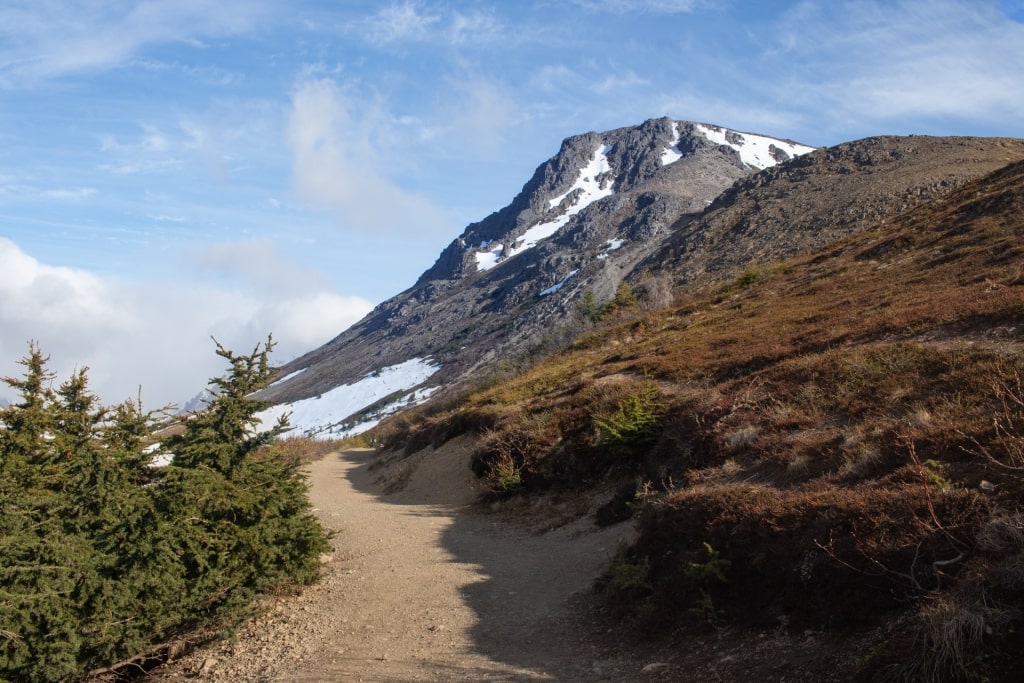
Flattop Mountain, Anchorage
Mount Denali may be at the top of just about every serious climber’s bucket list, but the title of “most climbed mountain in Alaska” goes to another peak.
Flattop Mountain stands at 3,510 feet tall, located in Chugach State Park, one of the most beautiful places in Alaska. It also offers some rather lovely views with relatively minimal logistical hassle.
For sheer accessibility, Flattop Mountain is hard to beat. For starters, the Glen Alps Trailhead is just a 30-minute drive from downtown Anchorage, which makes this perfect for a day trip. To make matters even easier, there’s a shuttle service that ferries travelers to the trailhead.
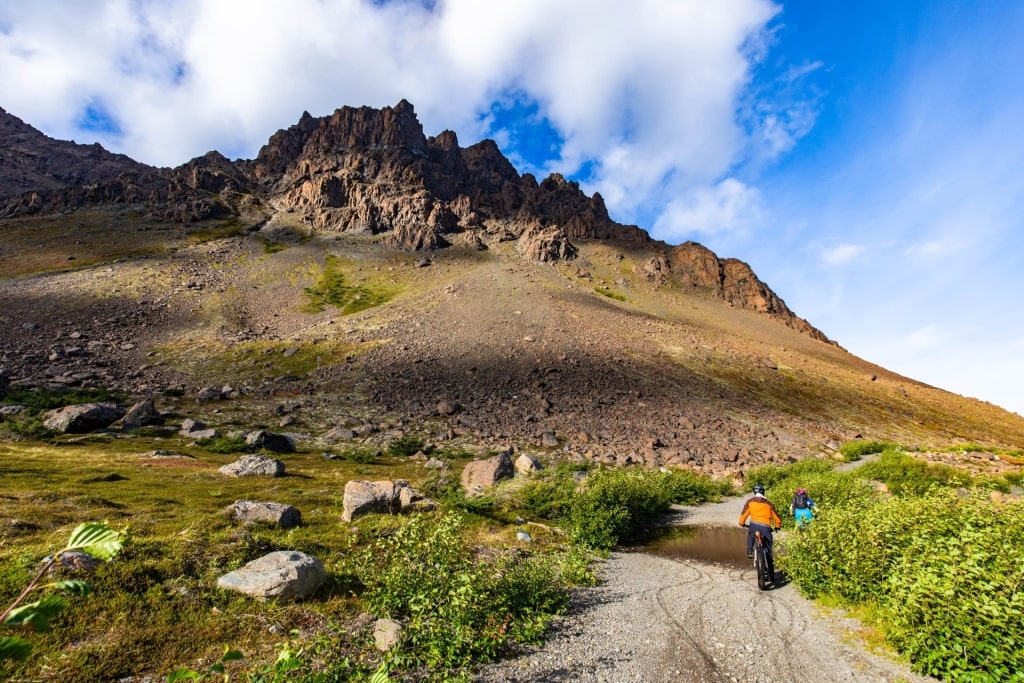
Glen Alps Trailhead in Flattop Mountain, Anchorage
Start your journey on the short, paved loop road towards the base, which is both picturesque and suitable for travelers in wheelchairs or with other mobility issues.
If you’re craving a more adventurous climb, Flattop Mountain has that as well. Blueberry Loop is a scenic route that extends for three miles and climbs just over 1,500 feet. Note that the last stretch involves a steep ascent on iron rungs made of old railroad ties.
If you’re in luck during the summer months, you may find out firsthand how the trail got its name. Alaska’s hiking trails are often lined with wild berry bushes. Keep an eye out for wild blueberries, as well as more unusual fruits like the blush-colored salmon berries.
Kincaid Park, Anchorage
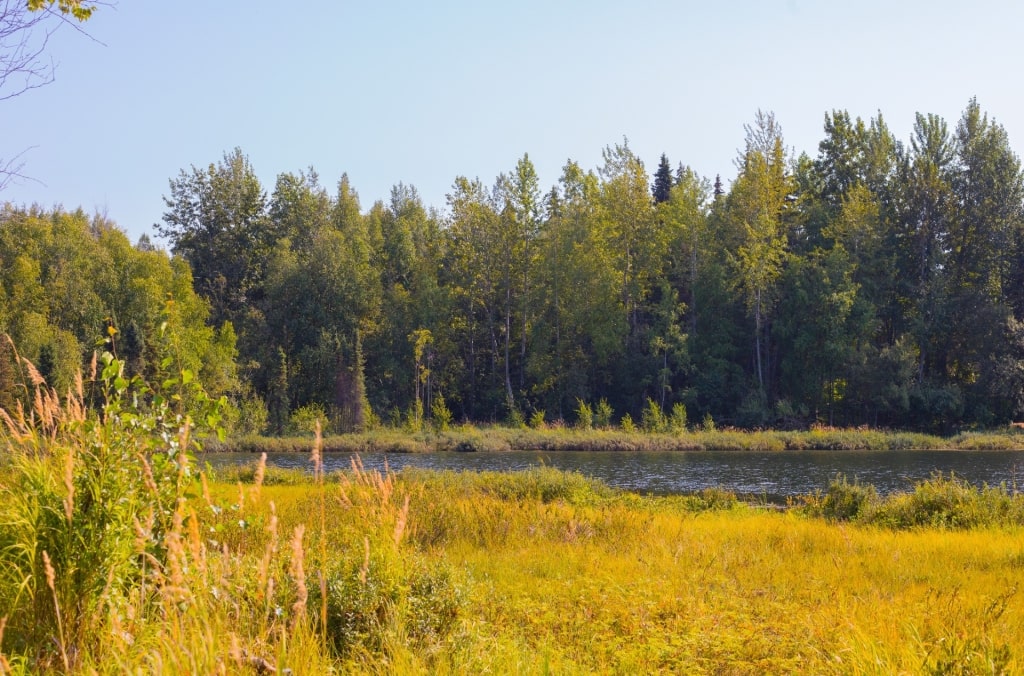
Kincaid Park, Anchorage
Locals in the Alaskan capital sometimes joke that the best thing about Anchorage is getting out of it. This is not to say that there’s nothing to do in Anchorage. The culturally diverse city offers plenty of diversions of its own.
But most Alaskans are, by nature, not exactly big city people. When the weekends come, there’s often a mass migration to the surrounding woods.
For locals looking to answer the call of the wild without a long journey, Kincaid Park is the perfect answer. This 1,500-acre public park was built on the site of what was once a Cold War Missile base.
Today, it’s home to roughly 40 miles of winding, well-maintained trails. They’re equally perfect for hiking and mountain biking. It’s also a breezy 15-minute cab right from downtown Anchorage.
There’s much more to do in Kincaid Park than just stroll around the grounds. From mazes to a pond stocked with rainbow trout to an archery range, this public recreation area has it all. The park also boasts the largest sand dune in Alaska, which has an impressive view. On rare clear days, keep your eyes peeled for the summit of Mount Denali in the distance.
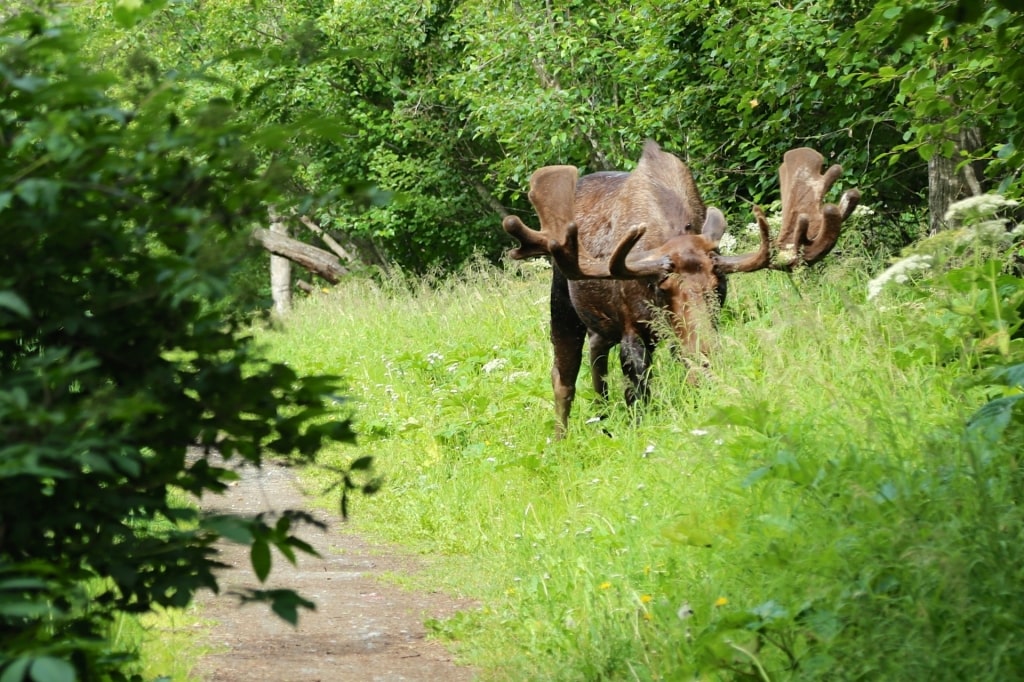
Moose
Even though the park is technically part of the state’s largest city, it’s still home to all sorts of charismatic megafauna that Alaska is known for.
Keep a watchful eye out for black bears and moose, both of which regularly frequent the paths. If you’re lucky, you might even spot a pod of beluga whales swimming off the shore of Kincaid Beach.
Lake Clark National Park, near Anchorage
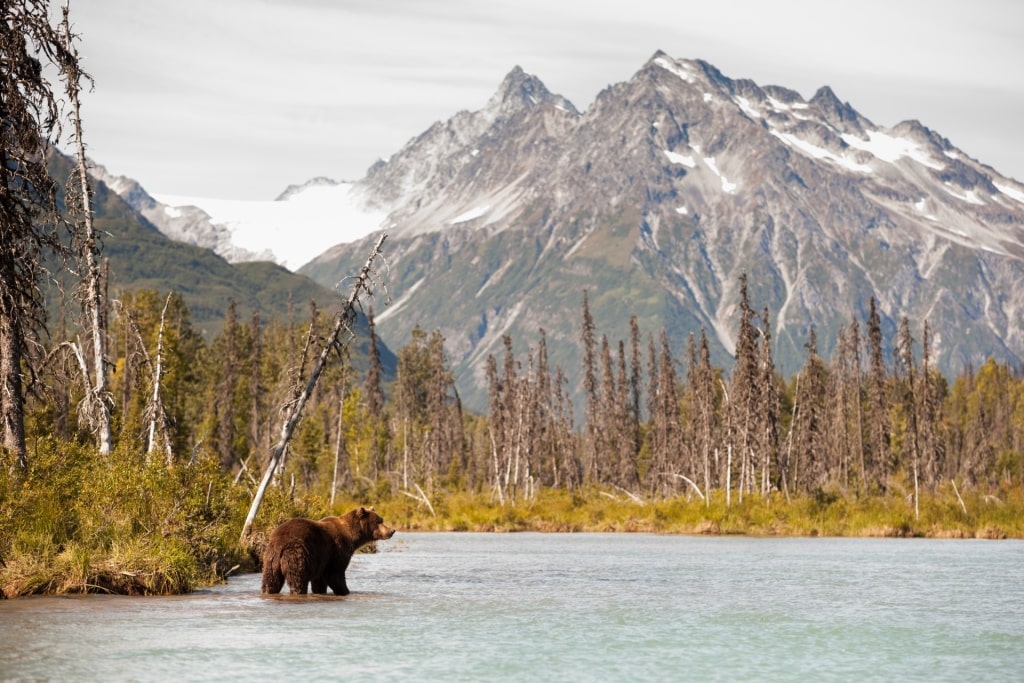
Lake Clark National Park, near Anchorage
It may be just a stone’s throw from the capital, but Lake Clark National Park truly feels like the wilderness. This protected area is a must-do in Alaska, popular with day hikers from the city, as well as backpackers seeking longer off-grid adventures.
Much of the national park has been deliberately left as tundra, unmarred by any evidence of human activity. Standing in near total silence among the Sitka spruce here is an awe-inspiring experience.
There are a number of trails around the Port Alsworth area, all of which are suitable for an afternoon hike. The easiest and best option for families with younger travelers is the Beaver Pond Loop Trail. With an elevation gain of 600 feet, this three-mile trail wraps around as a shallow pond lined with birch trees.
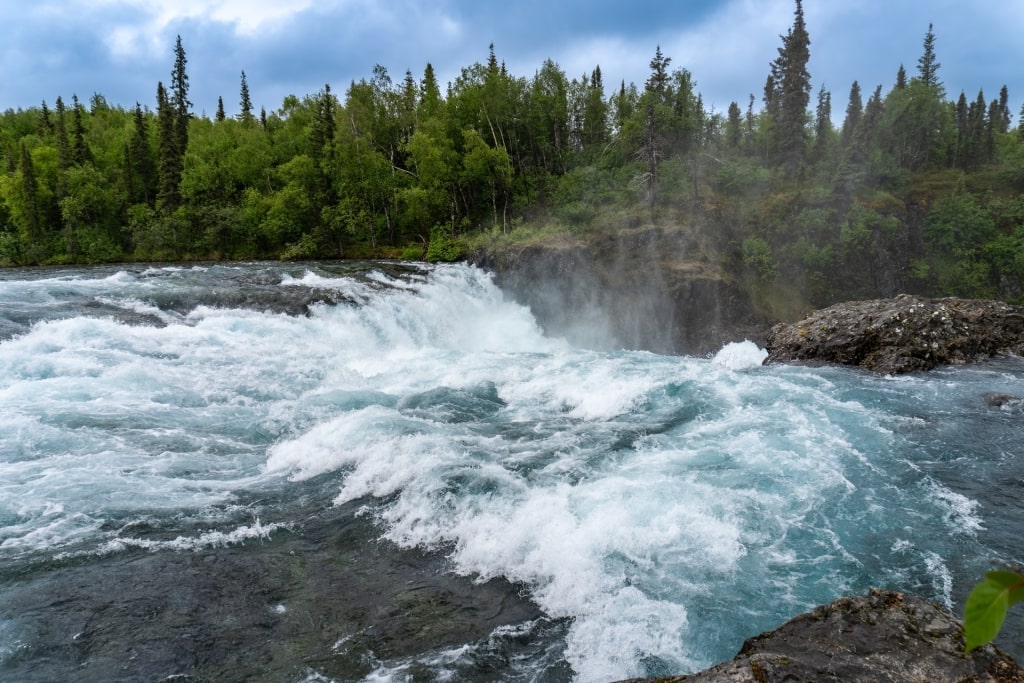
Tanalian Falls in Lake Clark National Park, near Anchorage
If you’re looking for a slightly longer hike, it’s possible to connect this to the four-mile Tanalian Falls Trail. The route is largely surrounded by forest, but you’ll catch glimpses of Tanalian Mountain and Lake Clark along the way.
If you make it to the end, you’ll have a particularly satisfying reward: the sight of the roaring Tanalian Falls.
Finally, it’s possible to extend the Tanalian Falls Trail into a five-mile hike, known as the Kontrashibuna Lake Trail. Keep walking past the falls until you reach the lake’s edge. All of these hikes are relatively moderate in difficulty and suitable for most hikers.
Mount Marathon, Seward
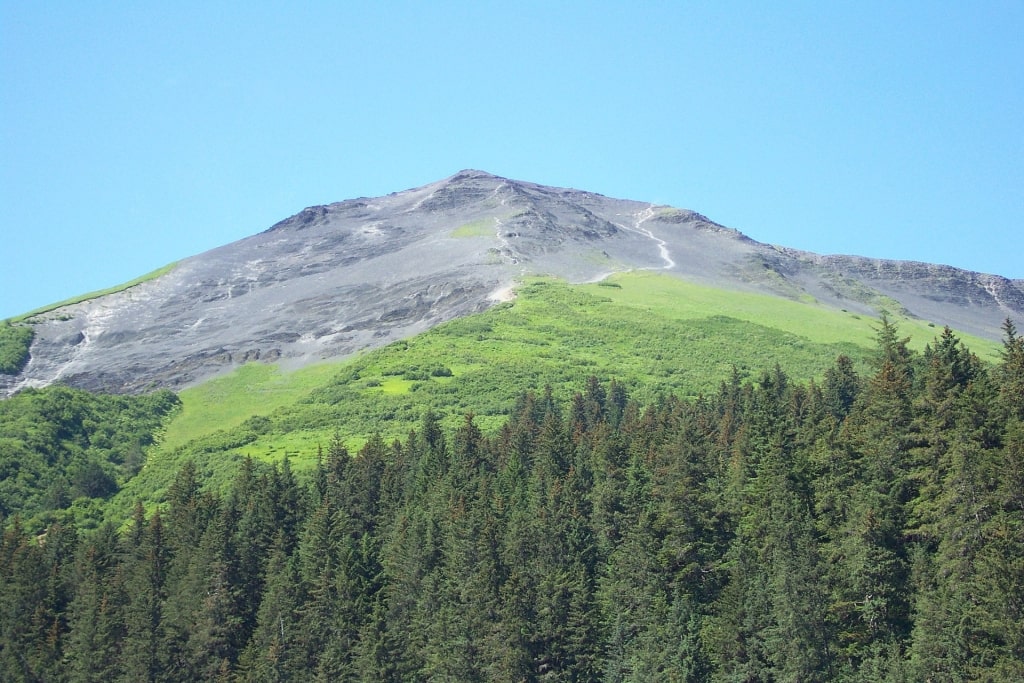
Mount Marathon, Seward
Alaska’s wilderness has a way of drawing people who enjoy testing the limits of what human beings are physically capable of. Every Fourth of July, hundreds of runners gather for the Mount Marathon Race, in which contestants dash up vertiginous slopes. With a steep, one-and-a-half-mile trek along rocky, uneven terrain, Mount Marathon is a real test of skill and endurance.
Even seasoned marathon runners often struggle with the dramatic elevation change. Each year, thousands more applicants enter a lottery for the chance to earn the ultimate bragging rights. Locals in Seward come together to cheer on contestants and hand out water.
Even if you’re not one of the lucky—or unlucky, depending on your perspective—few to race to the summit, you can still discover the route at your own pace. Mount Marathon is one of the most beautiful mountains in Alaska. As you creep towards the summit, remember to turn your camera lens toward the sweeping views of Resurrection Bay.
Read: Things to Do in Seward
Mount Juneau Trail, Juneau
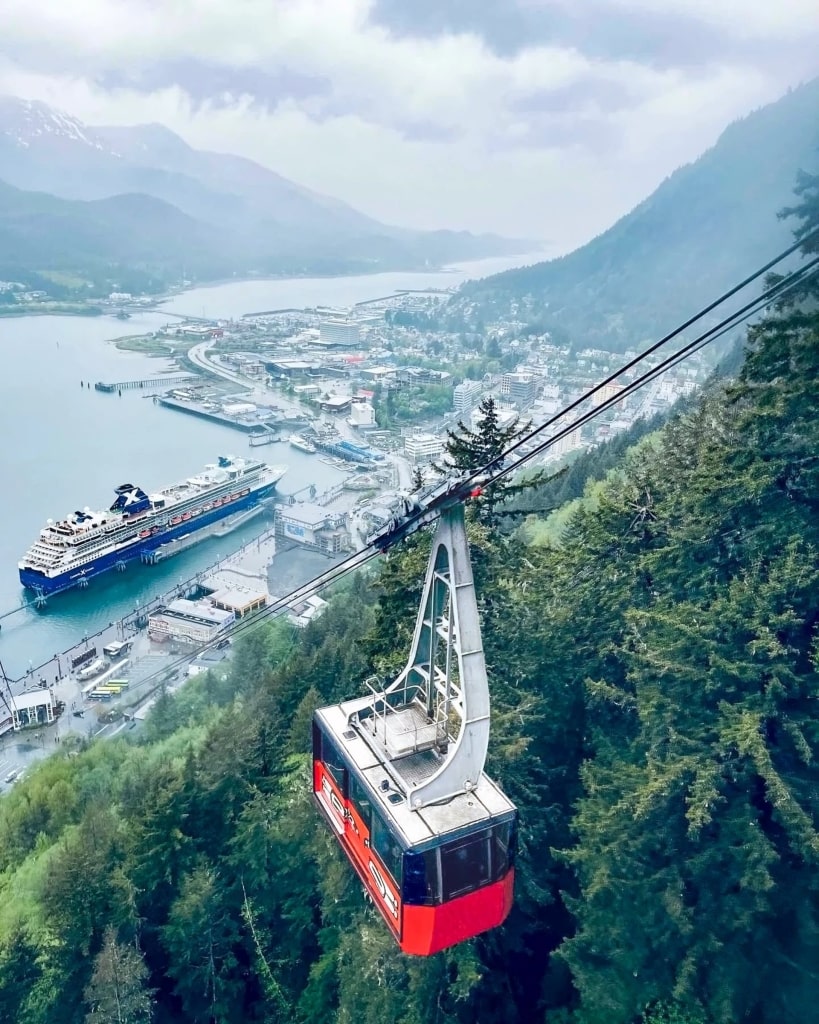
Mount Juneau, Juneau
Most visitors to Juneau in search of heart-stopping views take the easy route: the Goldbelt Mount Roberts Tramway. This aerial tram starts right near the city’s main pier and zooms 1,800 feet up the side of Mount Roberts.
Along the way, visitors will glimpse the densely forested slopes of the Chilkat Mountains. At the top, there are a few relatively easy hiking trails suitable for most levels, as well as travelers with children.
As enjoyable as the tram is, however, for more adventurous travelers it lacks the satisfaction of ascending a summit on your own two feet. For athletically inclined travelers with some hiking and trekking experience, nearby Mount Juneau offers a number of more challenging trails.
Standing 3,576 feet tall, the mountain looms imposingly over its namesake city.
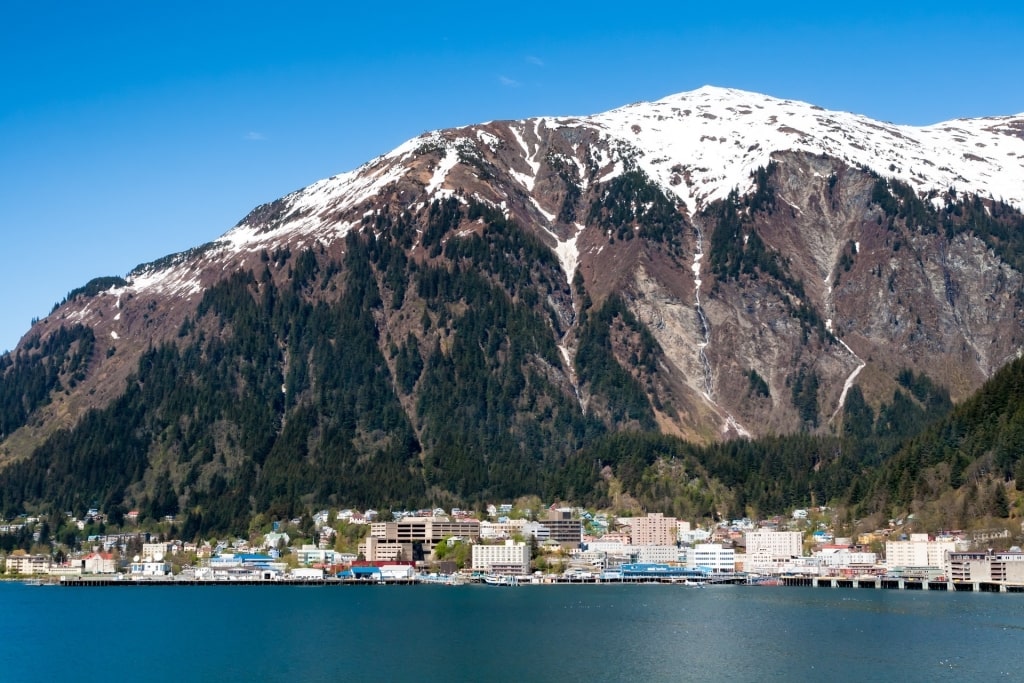
Mount Juneau, Juneau
While there are a number of trails along the mountain, the Mount Juneau Trail, one of the best hikes in Alaska, may be one of the most suitable for day-trippers who don’t want to commit to a 12-hour hike. At three miles long, this trail is short but strenuous, with a 1,500-foot elevation climb.
Since there are a number of steep drop-offs on the mountain, it’s especially important to stick to the trail here. If you find yourself out of breath at points on this route, don’t worry. The sweeping panorama of the Gastineau Channel at the top is worth it.
Deer Mountain Trail Road, Ketchikan
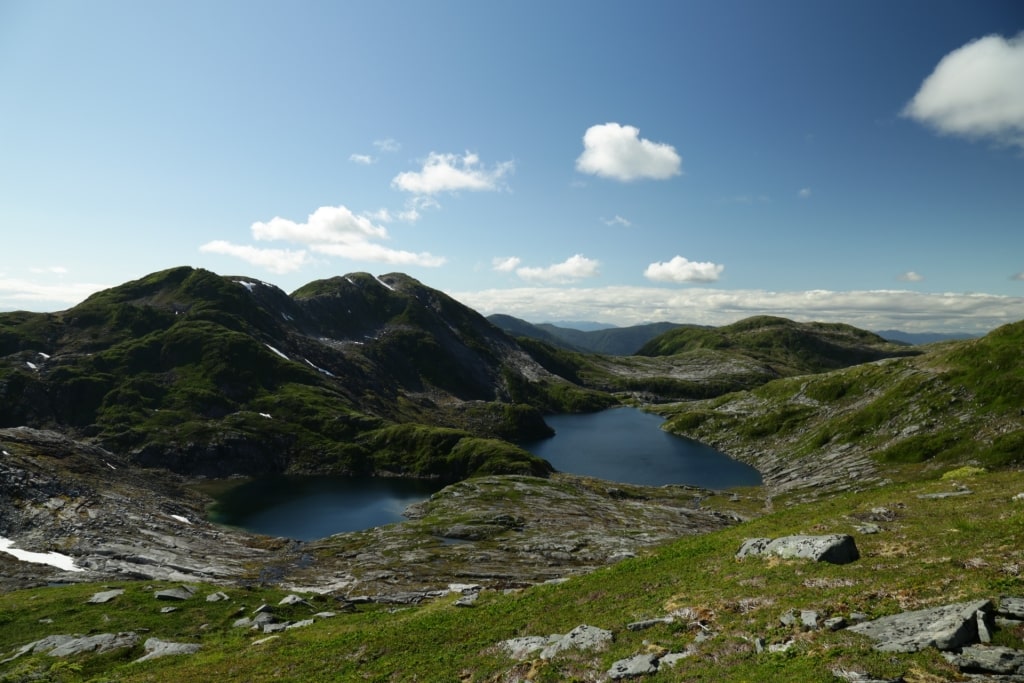
Deer Mountain, Ketchikan
Residents in Ketchikan are particularly fond of Deer Mountain, which stands majestically over the area. The mountain is plenty photogenic from the ground level, but it also makes for an especially enjoyable day hike.
Unlike some of Alaska’s more daunting peaks, Deer Mountain typically remains free of snowfall during the summer months. Deer Mountain Trail Road is a particularly well-maintained path, with several bridges over running water. Railings and embedded logs provide additional support at key points.
Covering five miles in distance and rising 2,600 feet, Deer Mountain Trail Road is not for amateurs or anyone averse to breaking a sweat. Still, it’s a manageable, if strenuous, day trek for more experienced hikers. It also offers a clear payoff for all of that extra exertion.
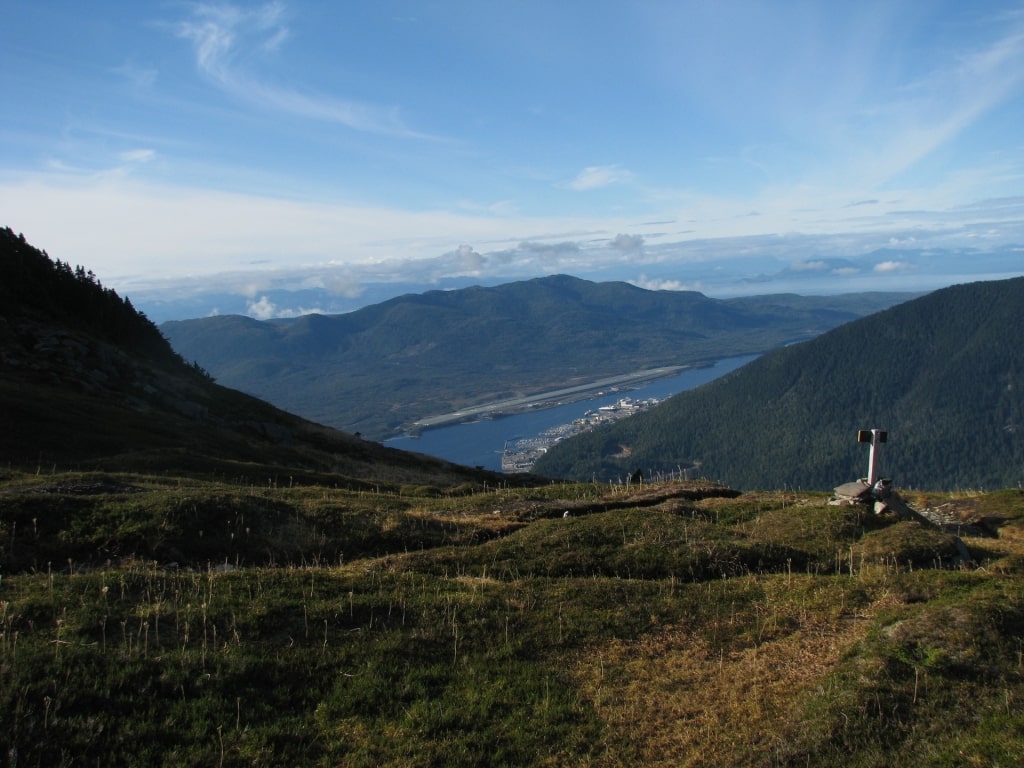
View from Deer Mountain, Ketchikan
The trail starts off shrouded by thick spruce forest. As hikers ascend a series of sharp switchbacks up the face of the mountain, the foliage clears to reveal jaw-dropping views. On clear days, you can see all the way to British Columbia towards the top. There are also unimpeded views of downtown Ketchikan, Ketchikan Lake, as well as several islands.
As a bonus, there’s a modest A-frame shelter built by the National Forest Service along the way. It’s designed to offer refuge for travelers hoping to spend the night far from human civilization. For day hikers, it makes for a convenient pit stop before returning to the town.
Yakutania Point / Smuggler’s Cove, Skagway
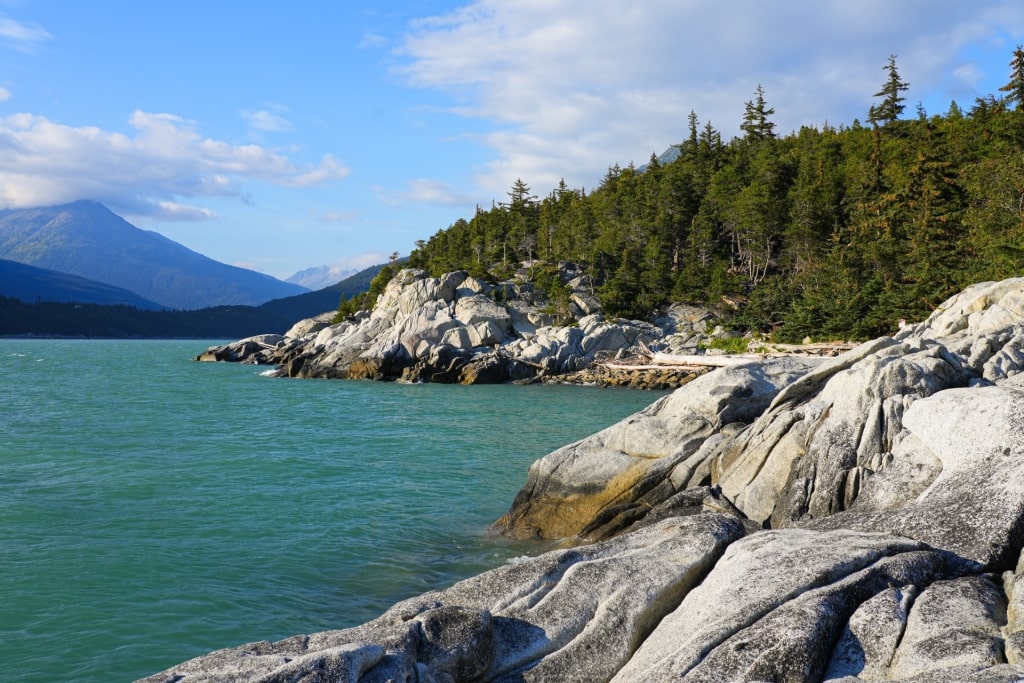
Yakutania Point, Skagway
Smuggler’s Cove has a rather colorful past dating back to Skagway’s more rough-and-tumble history. As with other parts of the United States, many Alaskan residents were not overly fond of teetotalling Prohibition laws. Especially given the area’s Wild West vibe during the height of the Gold Rush, government-enforced sobriety didn’t go over well.
As a result, a thriving bootleg trade in bathtub gins and other moonshines sprang up. Back in the height of Prohibition, Smuggler’s Cove was a favored parking spot of the area’s rumrunners.
Nowadays, this tidal inlet sees a lot less illicit activity and a lot more families on day hikes. The cove is a key stop on a gentle, two-mile loop hike. The Yakutania Point / Smuggler’s Cove walk is popular with parents, since it’s suitable for kids and teens.
To embark on this journey, start on First Avenue, make a left on Main Street, then head to the footbridge over Skagway River. Start to finish, the walk should take you no more than an hour.
Winner Creek Trail, Girdwood
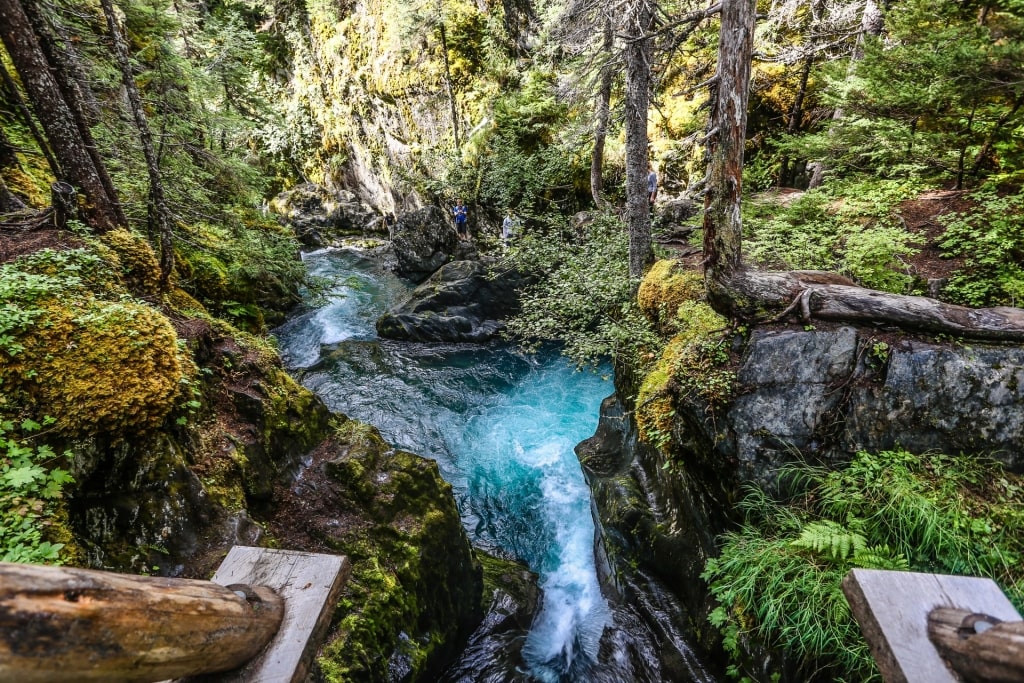
Winner Creek Trail, Girdwood
Girdwood Valley is both a popular day trip from Anchorage and a booming destination in its own right. Located a 45-minute drive from the capital, this area boasts jaw-dropping mountainous scenery, not to mention some of the best hiking in all of Alaska.
It certainly helps that the snow-capped summits of the Chugach Mountain Range are in just about every direction.
There are an almost overwhelming number of hiking trails that weave through Girdwood Valley. Winner Creek Trail is one of the most popular. This route is really two distinct trails, which makes this something of a choose-your-own-adventure situation.
Ambitious hikers and mountain bikers may opt for the Upper Winner Creek Trail. Note that the full route, which is nine miles out, is tough to cram into an afternoon. Many hikers with time constraints may prefer just to tackle a portion of it before turning around.
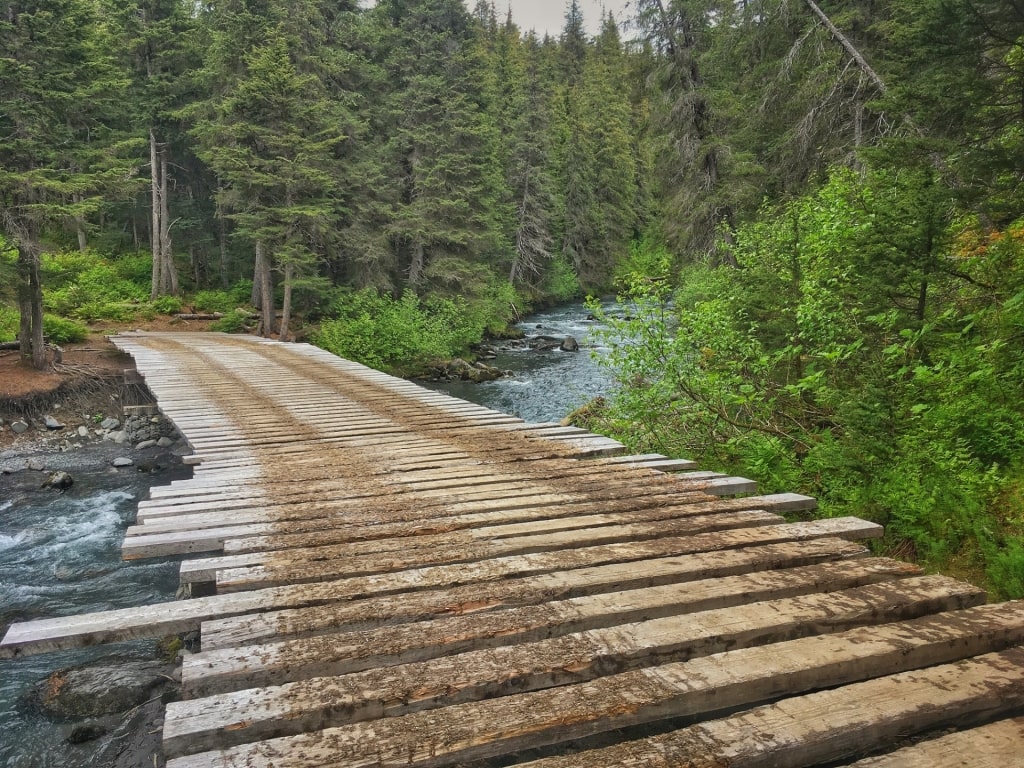
Winner Creek Trail, Girdwood
The vast majority of travelers opt for the Lower Winner Creek Trail. This three-mile hike extends from Alyeska Tram building to Crow Creek Road. The broad, well-maintained path is easy to navigate and suitable for hikers of all levels and ages.
It also packs a lot to see into a relatively short distance. The majority of the trail runs right through the densest parts of a temperate rainforest. Along the way, visitors will pass the roaring white water rapids of Winner Creek Gorge and take a hand tram over Glacier Creek.
Chena Riverwalk, Fairbanks
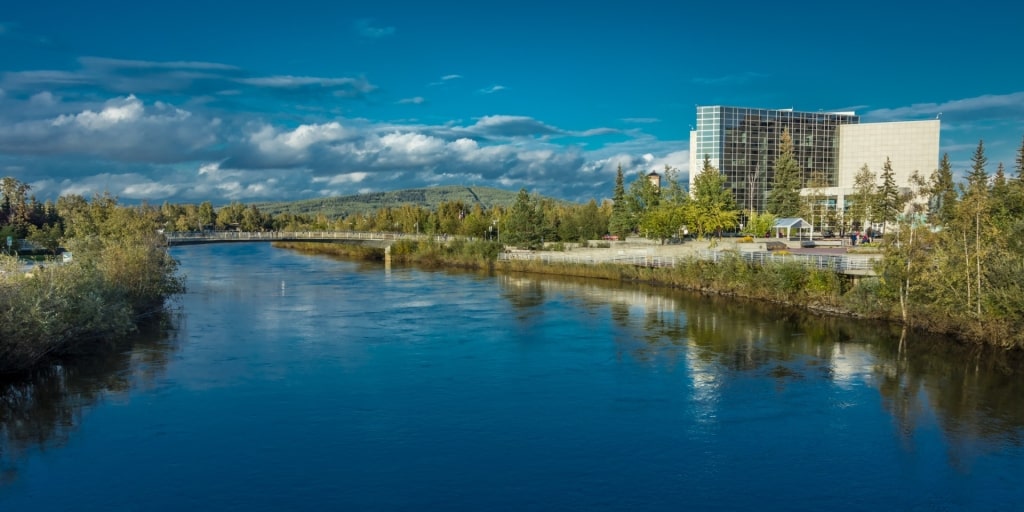
Chena Riverwalk, Fairbanks
There’s truly no better way to explore historic Fairbanks than on foot. This flat, paved walkway runs a little over three miles through the heart of downtown. As the name implies, it hugs the banks of the Chena River the whole way.
During summer in Alaska, virtually the entire route is in bloom with thousands of wildflowers. It also passes many of the most culturally significant landmarks and places in Alaska’s second largest city. The walkway starts at Pioneer Park, then wends its way to Airport Way.
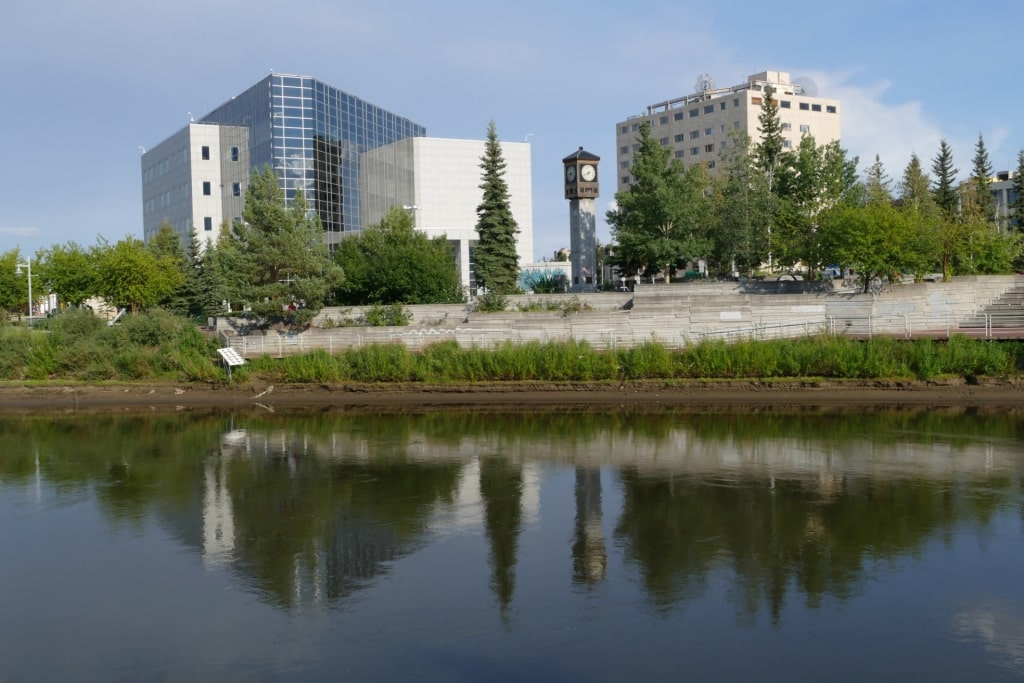
Golden Heart Plaza, Fairbanks
Aside from the centuries-old homes, you’ll pass the Riverfront Theatre, Griffin Park, and Golden Heart Plaza. The latter is home to the Unknown First Family Statue and is home to a time capsule destined to be open in 2059. The plaza also hosts the headquarters of the Yukon Quest, one of the longest and most grueling dog sled races in the world.
Don’t miss the summer art installation on the Rabinowitz Courthouse, which mimics the ever-shifting colors of the Northern Lights. And finally, everyone’s favorite attraction along the walkway is easily the antler arch. Millions of visitors to Fairbanks have snapped photos under this impressive sculpture made of discarded antlers.
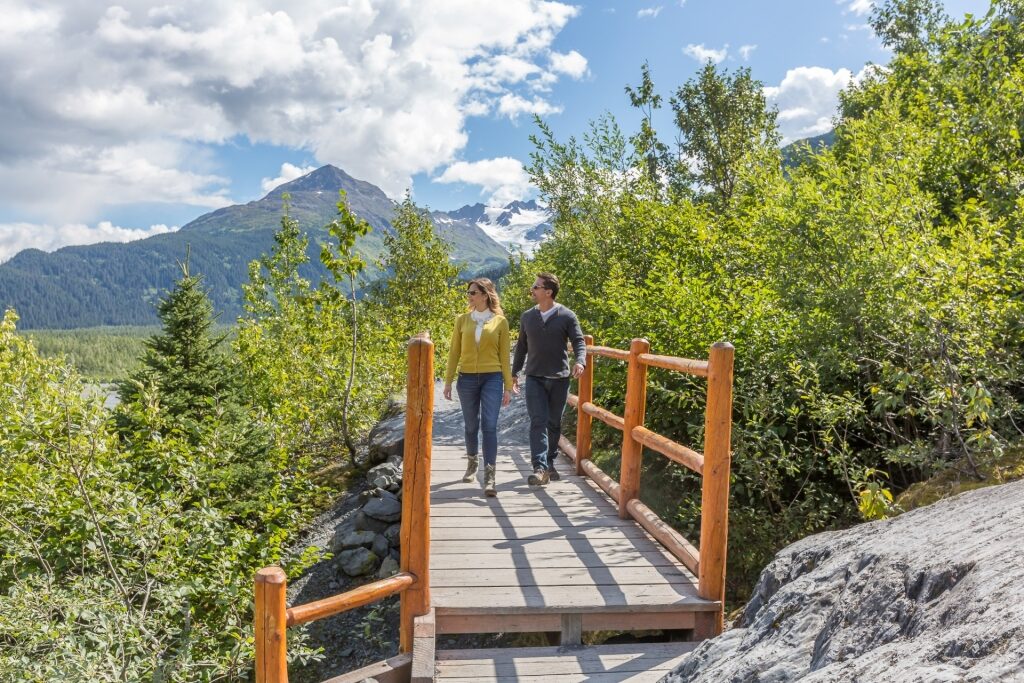
Hiking to Exit Glacier
Discover the best of the Last Frontier on a cruise to Alaska. Marvel at awe-inspiring glaciers, get up close with native wildlife, and experience some of the best hikes in Alaska.
Browse Alaska cruise itineraries on our website and book your next unforgettable adventure today.
